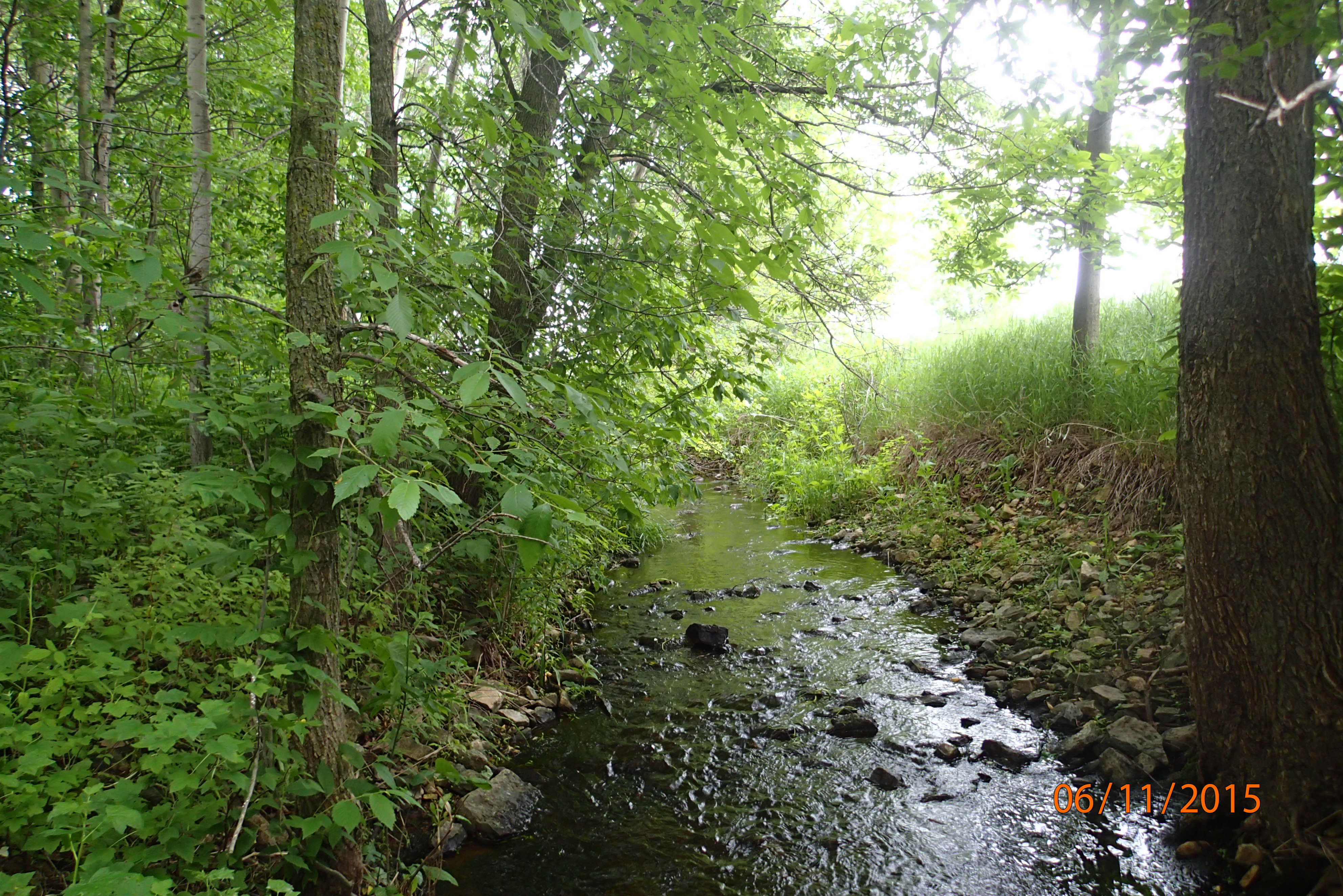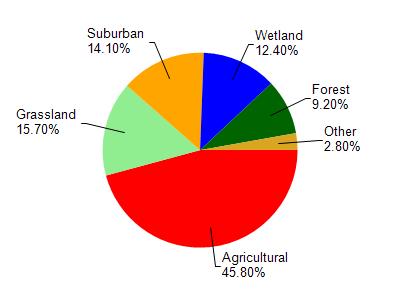
12.77 Miles
0 - 12.77
Macroinvertebrate, Cool-Cold Headwater, Cool-Warm Headwater
2018
Good
Sediment/Total Suspended Solids
Total Phosphorus, Sediment/Total Suspended Solids
Brown, Outagamie
No
No
Yes
Fish and Aquatic Life
Overview
Trout Creek is an 8-mile hard water stream that is a tributary to Duck Creek. Trout Creek is classified as a warm water sport fishery. Trout Creek drains 19.5 square miles of land, of which 74% is agricultural. The lower and mainstem reach have relatively steep topography, are well buffered by woodlands and have few nonpoint source impacts. The headwaters originate in areas with more gentle topography, poor buffering and significant nonpoint source impacts. Habitat evaluations conducted in 1995 ranked the creek from "poor" to "fair". HBI values taken at Western Drive indicated "good" water quality. Dissolved oxygen (D.O.) readings taken during the summer of 1995 showed significant diurnal D.O. swings with several violations of the 5 mg/l state standard. Water chemistry results from the spring of 1995 depicted very high amounts of suspended solids. The upper reaches of Trout Creek would greatly benefit from nonpoint source controls (Johnson 1996).
Date 1999
Author Cheryl Bougie
Condition
Wisconsin has over 84,000 miles of streams, 15,000 lakes and milllions of acres of wetlands. Assessing the condition of this vast amount of water is challenging. The state's water monitoring program uses a media-based, cross-program approach to analyze water condition. An updated monitoring strategy (2015-2020) is now available. Compliance with Clean Water Act fishable, swimmable standards are located in the Executive Summary of Water Condition in 2018. See also the 'monitoring and projects' tab.
Reports
Recommendations
Monitor Water Quality or Sediment
Category 3. 2018 TP Results: May Exceed. Station: 10041583. AU: 10853.
Navigability Determination
NE SW S28 T24N R19E; Trout Creek, trib;
Navigability Determination
NE SE S28 T24N R19E; Trout Creek, trib;
Navigability Determination
S26 T24N R19E; Trout Creek, trib;
Management Goals
Wisconsin's Water Quality Standards provide qualitative and quantitative goals for waters that are protective of Fishable, Swimmable conditions [Learn more]. Waters that do not meet water quality standards are considered impaired and restoration actions are planned and carried out until the water is once again fishable and swimmable
Management goals can include creation or implementation of a Total Maximum Daily Load analysis, a Nine Key Element Plan, or other restoration work, education and outreach and more. If specific recommendations exist for this water, they will be displayed below online.
Monitoring
Monitoring the condition of a river, stream, or lake includes gathering physical, chemical, biological, and habitat data. Comprehensive studies often gather all these parameters in great detail, while lighter assessment events will involve sampling physical, chemical and biological data such as macroinvertebrates. Aquatic macroinvertebrates and fish communities integrate watershed or catchment condition, providing great insight into overall ecosystem health. Chemical and habitat parameters tell researchers more about human induced problems including contaminated runoff, point source dischargers, or habitat issues that foster or limit the potential of aquatic communities to thrive in a given area. Wisconsin's Water Monitoring Strategy was recenty updated.
Grants and Management Projects
Monitoring Projects
| WBIC | Official Waterbody Name | Station ID | Station Name | Earliest Fieldwork Date | Latest Fieldwork Date | View Station | View Data |
|---|
| 5016644 | Unnamed | 10054794 | Oneida Nation - CTH U | | | Map | Data |
| 410200 | Trout Creek | 10051259 | Trout Creek 400m DS of Easement off Creek Vallley Dr | 7/10/2018 | 7/10/2018 | Map | Data |
| 410200 | Trout Creek | 053037 | Trout Creek at County Hwy Ff | 8/9/1995 | 8/11/2015 | Map | Data |
| 5017309 | Unnamed | 10054794 | Oneida Nation - CTH U | | | Map | Data |
| 410200 | Trout Creek | 453281 | Trout Creek at Cth U Near Ashwaubenon WI | 2/23/2000 | 10/6/2015 | Map | Data |
| 410200 | Trout Creek | 10010665 | Trout Creek | | | Map | Data |
| 410200 | Trout Creek | 10051261 | Trout Creek 10m US of Brookwood Dr | 7/10/2018 | 7/10/2018 | Map | Data |
| 3000577 | Unnamed | 10054794 | Oneida Nation - CTH U | | | Map | Data |
| 410200 | Trout Creek | 10045062 | Trout Creek at Brookwood West | | | Map | Data |
| 410200 | Trout Creek | 10054794 | Oneida Nation - CTH U | | | Map | Data |
| 5017728 | Unnamed | 10054794 | Oneida Nation - CTH U | | | Map | Data |
| 410200 | Trout Creek | 10008253 | Trout Creek (1) US f Trout Creek Rd. | 10/3/2001 | 10/3/2001 | Map | Data |
| 410200 | Trout Creek | 10041583 | Trout Creek-Hillcrest Dr | 5/14/2013 | 8/14/2018 | Map | Data |
| 3000575 | Unnamed | 10054794 | Oneida Nation - CTH U | | | Map | Data |
| 410200 | Trout Creek | 10008254 | Trout Creek (2) 17.6m Upstream Of Overland Rd. | 10/3/2001 | 7/9/2018 | Map | Data |
| 410200 | Trout Creek | 053685 | Trout Creek - Riverdale Rd | 4/25/1995 | 4/25/1995 | Map | Data |
| 5016545 | Unnamed | 10054794 | Oneida Nation - CTH U | | | Map | Data |
| 5544358 | Unnamed | 10054794 | Oneida Nation - CTH U | | | Map | Data |
| 410200 | Trout Creek | 10051417 | Trout Creek Oneida Trail Access | 7/10/2018 | 7/10/2018 | Map | Data |
| 410200 | Trout Creek | 10008255 | Trout Creek (3) Downstream Of Cty U - S. Branch At Junction | 10/3/2001 | 6/27/2018 | Map | Data |
| 410200 | Trout Creek | 053484 | Trout Creek - Near Howard WI at Cnty Rd FF | | | Map | Data |
| 410200 | Trout Creek | 053561 | Trout Creek - Near Ashwaubenon WI | 5/24/2001 | 10/18/2001 | Map | Data |
| 410200 | Trout Creek | 053694 | Trout Creek-Trout Creek Dr. | 10/11/2001 | 8/11/2015 | Map | Data |
| 410200 | Trout Creek | 10010666 | Trout Creek - 2 | 10/12/1998 | 10/12/1998 | Map | Data |
|

Watershed Characteristics
Trout Creek is located in the Duck Creek watershed which is 151.61 mi². Land use in the watershed is primarily agricultural (45.80%), grassland (15.70%) and a mix of suburban (14.10%) and other uses (24.40%). This watershed has 302.11 stream miles, 2,064.01 lake acres and 8,189.35 wetland acres.
Nonpoint Source Characteristics
This watershed is ranked High for runoff impacts on streams, Not Available for runoff impacts on lakes and High for runoff impacts on groundwater and therefore has an overall rank of High. This value can be used in ranking the watershed or individual waterbodies for grant funding under state and county programs.However, all waters are affected by diffuse pollutant sources regardless of initial water quality. Applications for specific runoff projects under state or county grant programs may be pursued. For more information, go to surface water program grants.
Trout Creek is considered a Macroinvertebrate, Cool-Cold Headwater, Cool-Warm Headwater under the state's Natural Community Determinations.
Natural communities (stream and lake natural communities) represent model results and DNR staff valiation processes that confirm or update predicted conditions based on flow and temperature modeling from historic and current landscape features and related variables. Predicated flow and temperatures for waters are associated predicated fish assemblages (communities). Biologists evaluate the model results against current survey data to determine if the modeled results are corect and whether biological indicators show water quaity degradation. This analysis is a core component of the state's resource management framework. Wisconsin's Riverine Natural Communities.
Cool (Warm-Transition) Headwaters are small, sometimes intermittent streams with cool to warm summer temperatures. Coldwater fishes are uncommon to absent, transitional fishes are abundant to common, and warm water fishes are common to uncommon. Headwater species are abundant to common, mainstem species are common to absent, and river species are absent.
Cool (Cold-Transition) Headwaters are small, usually perennial streams with cold to cool summer temperatures. Coldwater fishes are common to uncommon (<10 per 100 m), transitional fishes are abundant to common, and warm water fishes are uncommon to absent. Headwater species are abundant to common, mainstem species are common to absent, and river species are absent.